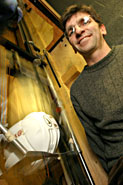Face-off against injury
Hockey verges on obsession in Canada. With over 500,000 playing organized hockey nationwide, Canadians love the game. Unfortunately, many of the same qualities that make hockey so enjoyable make it potentially dangerous. Battling hockey injury is McGill's David Pearsall, who combines engineering and biomechanics to improve hockey safety and performance.

Lab coordinator Dr. David Pearsall, Department of Kinesiology and Physical Education.
Owen Egan
Much of Pearsall's work focuses on improving the hockey helmet. Since the '60s, when helmets were first introduced to ice hockey, no players correctly wearing approved helmets have fractured their skulls; however, an increasing number of players suffer concussions. The need to evaluate the role of the ice hockey helmet is evident. "Though our understanding of the nature of concussions is a grey area, we know that helmets can reduce the risk and severity of concussions," explained Pearsall. "To do this, a helmet must be designed to sustain multiple impacts of various magnitudes." A helmet that will protect against concussions and other injuries should not simply withstand the greatest force possible — it must be resilient to repeated falls and hits.
Systematically testing hockey helmets reveals which designs, materials and constructions work best to protect heads, and which ones crack under the pressure. In Pearsall's lab at the Department of Kinesiology and Physical Education, a guillotine-like machine drops five-kilogram surrogate "heads" wearing helmets onto a steel surface from a metre above. After being dropped, helmets are visually inspected for cleavages in their plastic shells and foam liners. More importantly, acceleration measures determine impact magnitudes with respect to known human tolerances. Pearsall is currently developing a new technique to monitor how impact stresses are distributed within the helmet, using piezoceramic sensors. These sensors are small enough to fit into a helmet. When helmets are subjected to impact, the crystal structure within each sensor gets squeezed and creates an electric charge that in turn corresponds to known pressures. Monitoring the location and magnitude of these charges may pinpoint exactly where pressures at the helmet-to-head interface are too high, allowing helmet designs to be finely tuned for maximum protection.
Pearsall recognizes that the pool of hockey players is diverse, and he wants to apply the piezoceramic sensors approach to assess hockey helmets for specific player groups. For example, children's helmets are tested using standards based on adult models, but injuries on developing skulls and brains are different from those experienced by adults. This could have implications for children's helmet designs, and distinct helmets and testing standards can be developed. Helmet testing involving piezo-ceramic sensors could ensure comfortable and effective helmets for all hockey players even as the equipment requirements among athletes diverge.
Ice hockey equipment is not limited to helmets. Pearsall has been involved in developing and assessing safety standards for other hockey gear such as elbow, shoulder and shin pads. "Head and neck injuries are the most serious kinds sustained by hockey players, but other less serious injuries are preventable," explains Pearsall. "Right now, body equipment does not need to pass a safety certification, and with such a range of equipment available, creating realistic but effective standard tests is a necessary step for hockey's evolution."
Pearsall cautions against placing too much faith in hockey equipment. "There is no magic solution to prevent ice hockey injuries. Equipment provides physical intervention from impact during the game, but it cannot account for human behaviour." Pearsall worries that athletes develop a false sense of security because they are wearing equipment, and this leads to reckless play, such as high-sticking and hitting from behind. Players wearing helmets sometimes feel invincible, but helmets do not protect necks or spines. To combat such misconceptions, Pearsall co-organized an international symposium on ice hockey safety, and he has been involved in several organizations promoting hockey safety through education. He cites the success of the American "Heads Up" campaign, in which young hockey players learn to keep their heads up when falling, thus minimizing the chance of a neck fracture. Pearsall emphasizes that athletes, parents, manufacturers and scientists are all involved in keeping hockey safe.
Working at Canada's only major non-commercial hockey research facility, Pearsall hopes that his work will continue to improve the safety and performance of all hockey participants, from players suiting up for a McGill D-League intramural battle to those on ice at the next Habs game.
David Pearsall is funded by NSERC, Bauer-Nike Hockey and McGill University. McGill's SPARK program (Students Promoting Awareness of Research Knowledge) is funded by NSERC and run by the Faculty of Education, VP Research Office and the University Relations Office. See Spark website.
